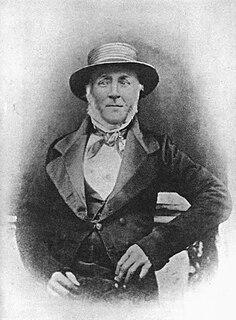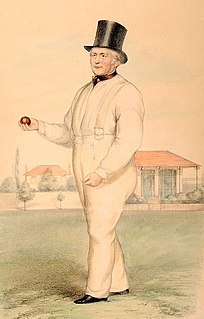Related Research Articles
Arthur Haygarth was a noted amateur cricketer who became one of cricket's most significant historians. He played first-class cricket for the Marylebone Cricket Club and Sussex between 1844 and 1861, as well as numerous other invitational and representative teams including an England XI and a pre-county Middlesex. A right-handed bat, Haygarth played 136 games now regarded as first-class, scoring 3,042 runs and taking 19 wickets with his part-time bowling. He was educated at Harrow, which had established a rich tradition as a proving ground for cricketers. He served on many MCC committees and was elected a life member in 1864.
The Napoleonic Wars had deprived cricket of investment and manpower, particularly after 1810 as the conflict in the Peninsular War reached its height and the invasion of France followed. A recovery began in 1815, the year of the Battle of Waterloo, and a more widespread return to normality can be observed from 1816, although it was not until 1825 that inter-county matches resumed when Kent played Sussex.

William Lambert was an English professional cricketer in the first two decades of the 19th century. Playing mainly for Surrey from 1801, but also for Marylebone Cricket Club (MCC) and some other county teams, Lambert was a right-hand batsman and an underarm slow bowler.
The Sheffield Cricket Club was founded in the 18th century and soon began to play a key role in the development of cricket in northern England. It was the direct forerunner of Yorkshire County Cricket Club and some of the teams fielded by Sheffield were styled Yorkshire. Sheffield generally held first-class status, depending on the quality of their opponents, from 1827 to 1855.
1864 was the 78th season of cricket in England. It was a significant year in cricket history, as it saw the legalisation of overarm bowling and the first edition of John Wisden’s Cricketers’ Almanac.
1870 was the 84th season of cricket in England since the foundation of Marylebone Cricket Club (MCC). It was in many ways a bridge between two eras of the game and, in a summer comparable for hot and dry weather to 1887, 1911, 1976 or 1995, saw W.G. Grace for the second of three successive years establish a record run aggregate, late-blooming slow bowler James Southerton become the first bowler to take 200 first-class wickets in a season and the first use of the heavy roller at Lord's. Although the heavy roller had been patented several decades earlier, its use was never seriously considered by MCC management despite many protests over the danger posed by the Lord's pitch where extremely frequent “shooters” alternated with balls that “flew” over the batsman's head. These dangerous pitches were viewed as a symbol of virility by many amateur batsmen, however; though when remembering one of W.G.’s finest innings – 66 on one of the roughest Lord’s pitches against a very strong Yorkshire attack against Yorkshire – fast bowlers Freeman and Emmett wondered how the champion was not maimed or killed outright.
1803 was the 17th season of cricket in England since the foundation of Marylebone Cricket Club (MCC). Thomas Howard made his debut in important matches.
1804 was the 18th season of cricket in England since the foundation of Marylebone Cricket Club (MCC). The first Eton v Harrow match may have been played at Lord's Old Ground.
1805 was the 19th season of cricket in England since the foundation of Marylebone Cricket Club (MCC). Lord Frederick Beauclerk became the first batsman known to have scored two centuries in the same season.
1806 was the 20th season of cricket in England since the foundation of Marylebone Cricket Club (MCC). The first two Gentlemen v Players matches took place but the fixture was not revived until 1819.
1807 was the 21st season of cricket in England since the foundation of Marylebone Cricket Club (MCC). John Willes of Kent first tried to revive the idea of "straight-armed" bowling, which had originated with Tom Walker in the 1790s.
1808 was the 22nd season of cricket in England since the foundation of Marylebone Cricket Club (MCC). George Osbaldeston made his debut in important matches.
1809 was the 23rd season of cricket in England since the foundation of Marylebone Cricket Club (MCC). Thomas Lord opened his Middle Ground after refusing to pay increased rent at the Old Ground.
1810 was the 24th season of cricket in England since the foundation of Marylebone Cricket Club (MCC). William Ward made his debut in important matches and The Bs were dismissed for a total of only 6.

Frederick William Lillywhite was an English first-class cricketer during the game's roundarm era. One of the main protagonists in the legalisation of roundarm, he was one of the most successful bowlers of his era. His status is borne out by his nickname: The Nonpareil.
James "Jem" Broadbridge (1795–1843) was an English professional cricketer who is widely accounted the outstanding all-rounder in England during the 1820s. He is best remembered for his part in the introduction of roundarm bowling. He played mainly for Sussex and made 102 known appearances in first-class cricket from 1814 to 1840. He represented the Players in the Gentlemen v Players series and the South in the North v. South series.
Variations in published cricket statistics have come about because there is no official view of the status of cricket matches played in Great Britain before 1895 or in the rest of the world before 1947. As a result, historians and statisticians have compiled differing lists of matches that they recognise as "unofficially" first-class. The problem is significant where it touches on some of the sport's first-class records and especially the playing career of W. G. Grace.
Norfolk county cricket teams were the teams that represented the historic county of Norfolk before the first official formation of Norfolk County Cricket Club in 1876.
Cricket must have reached Hertfordshire by the end of the 17th century. The earliest reference to cricket in the county is dated 1732 and is also the earliest reference to Essex as a county team. On Thursday, 6 July 1732, a team called Essex & Hertfordshire played London Cricket Club in a first-class match at Epping Forest "for £50 a side". The result is unknown.
The period from 1772 to 1815 saw significant growth and development in English cricket to the point that it became a popular sport nationwide, having outgrown its origin in the southeastern counties. Prominent northern clubs were founded at Nottingham and Sheffield. The earliest known references have been found for cricket in Australia (1804), Canada (1785), South Africa (1808) and the West Indies. In India, British clubs were founded at Calcutta (1792) and, following the siege there, Seringapatam (1799). In America, the game was popular among soldiers in the revolution and George Washington is known to have played in at least one game.
References
- 1 2 Paul Donnelley (4 October 2010). Firsts, Lasts & Onlys of Cricket: Presenting the most amazing cricket facts from the last 500 years. Octopus. pp. 1891–. ISBN 978-0-600-62253-6.
- 1 2 "England Domestic Season at London, May 10-12 1790". Espncricinfo.com. Retrieved January 26, 2018.
- ↑ CricketArchive – First-class matches played by left-handed teams Archived 2016-03-07 at the Wayback Machine . Retrieved on 16 June 2013.
- ↑ CricketArchive – Left-Handed v Right-Handed, 1790. Retrieved on 16 June 2013.
- ↑ CricketArchive – Left-Handed v Right-Handed, 1828. Retrieved on 16 June 2013.
- ↑ CricketArchive – MCC v Left-Handed, 1833. Retrieved on 16 June 2013.
- ↑ CricketArchive – Left-Handed v Right-Handed, 1835. Retrieved on 16 June 2013.
- ↑ CricketArchive – MCC v Left-Handed, 1838. Retrieved on 16 June 2013.
- ↑ CricketArchive – Left-Handed v Right-Handed, 1870. Retrieved on 16 June 2013.